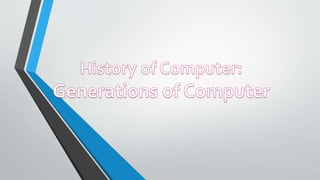History of Computer REPORTER EVELYN BARRIT.pptx
if you want to know more about the history of computer check this out and see the wonder of advantage and this advantages of computer in the history and in the present When we study the many aspects of computing and computers, it is important to know about the history of computers. Charles Babbage designed an Analytical Engine which was a general computer It helps us understand the growth and progress of technology through the times. It is also an important topic for competitive and banking exams.History of Computers Generation The word ‘computer’ has a very interesting origin. It was first used in the 16th century for a person who used to compute, i.e. do calculations. The word was used in the same sense as a noun until the 20th century. Women were hired as human computers to carry out all forms of calculations and computations. By the last part of the 19th century, the word was also used to describe machines that did calculations. The modern-day use of the word is generally to describe programmable digital devices that run on electricity. 1st Generation: This was from the period of 1940 to 1955. This was when machine language was developed for the use of computers. They used vacuum tubes for the circuitry. For the purpose of memory, they used magnetic drums. These machines were complicated, large, and expensive. They were mostly reliant on batch operating systems and punch cards. As output and input devices, magnetic tape and paper tape were implemented. For example, ENIAC, UNIVAC-1, EDVAC, and so on. 2nd Generation: The years 1957-1963 were referred to as the “second generation of computers” at the time. In second-generation computers, COBOL and FORTRAN are employed as assembly languages and programming languages. Here they advanced from vacuum tubes to transistors. This made the computers smaller, faster and more energy-efficient. And they advanced from binary to assembly languages. For instance, IBM 1620, IBM 7094, CDC 1604, CDC 3600, and so forth. 3rd Generation: The hallmark of this period (1964-1971) was the development of the integrated circuit. A single integrated circuit (IC) is made up of many transistors, which increases the power of a computer while simultaneously lowering its cost. These computers were quicker, smaller, more reliable, and less expensive than their predecessors. High-level programming languages such as FORTRON-II to IV, COBOL, and PASCAL PL/1 were utilized. For example, the IBM-360 series, the Honeywell-6000 series, and the IBM-370/168. 4th Generation: The invention of the microprocessors brought along the fourth generation of computers. The years 1971-1980 were dominated by fourth generation computers. C, C++ and Java were the programming languages utilized in this generation of computers. For instance, the STAR 1000, PDP 11, CRAY-1, CRAY-X-MP, and Apple II. This was when we started producing computers for home use. 5th Generation: These computers have been utilized since 1980 and continue to be used now.

Recommended
Recommended
More Related Content
Similar to History of Computer REPORTER EVELYN BARRIT.pptx
Similar to History of Computer REPORTER EVELYN BARRIT.pptx (20)
Recently uploaded
Recently uploaded (20)
History of Computer REPORTER EVELYN BARRIT.pptx
- 2. There are five generations of computer • First generation – 1946 to 1958 • Second generation – 1959 to 1964 •Third generation – 1965 to 1970 • Fourth generation – 1971 toToday • Fifth generation –Today to future
- 3. •The first computers used vacuum tubes for circuitry and magnetic drums for memory, and were often enormous, taking up entire rooms. The First Generation
- 4. • Transistors replaced vacuum tubes and ushered in the second generation of computers The Second Generation
- 5. • Second-generation computers moved from cryptic binary machine language to symbolic, or assembly, languages, which allowed programmers to specify instructions in words. Second generation computers still relied on punched cards for input and printouts for output.These were also the first computers that stored their instructions in their memory, which moved from a magnetic drum to magnetic core technology. • Examples: UNIVAC III, RCA 501, PhilcoTransact S-2000, NCR 300 series, IBM 7030 Stretch, IBM 7070, 7080, 7090 series
- 6. • The development of the integrated circuit was the hallmark of the third generation of computers TheThird Generation
- 7. • Transistors were miniaturized and placed on silicon chips, called semiconductors, which drastically increased the speed and efficiency of computers. It could carry out instructions in billionths of a second. Much smaller and cheaper compare to the second-generation computers.
- 8. • The microprocessor brought the fourth generation of computers, as thousands of integrated circuits were built onto a single silicon chip The fourth Generation
- 9. • As these small computers became more powerful, they could be linked together to form networks, which eventually led to the development of the Internet. •Fourth generation computers also saw the development of GUIs, the mouse and handheld devices.
- 10. •Based on Artificial Intelligence (AI). Still in development.The use of parallel processing and superconductors is helping to make artificial intelligence a reality. The Fifth Generation
- 11. •The goal is to develop devices that respond to natural language input and are capable of learning and self-organization. • There are some applications, such as voice recognition, that are being used today.